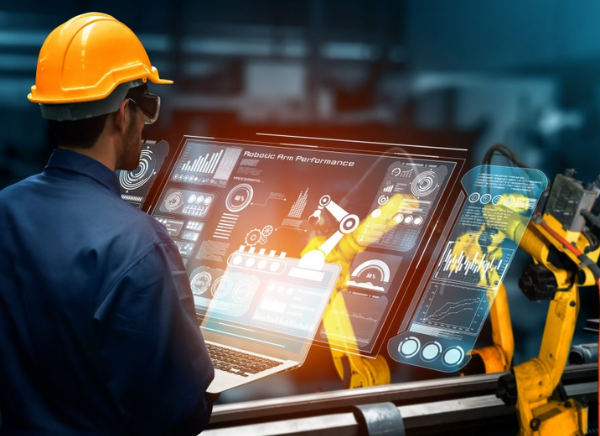
By Antoine Harb, Team Leader, Middle East, Kingston Technology

The global business landscape is witnessing a remarkable shift as organizations worldwide increasingly recognize the importance of digital twin applications. The digital twin trend encompasses virtual models or replicas of physical entities, such as products, plants, supply chain or infrastructure, facilitating the collection of valuable data. According to latest research, the global digital twin market is estimated to increase from USD 6.9 billion in 2022 to USD 73.5 billion by 2027, growing at a CAGR of 60.6% during the forecast period. This exponential growth underscores the transformative potential of digital twin technology across various sectors.
Digital twins offer a multitude of benefits across industries, providing valuable insights into product fortitude, functionality, and limitations. By simulating real-world scenarios, businesses can analyze and optimize their offerings before physical production, saving time, resources, and costs. Rapid diversification and rampant digitization, including the implementation of artificial intelligence (AI) over the last few years have enabled digital twins to be more accurate across different sectors.
There can be varying levels of digital twin adoption, depending on the sector and requirements. At a basic level, companies can simply use this technology to monitor their assets and collect data for analysis. At a second level, digital twins can be used to run simulations and run through different scenarios to analyze and refine processes. At an advanced level, digital twins can be coupled with AI technology to detect anomalies and find solutions.
Several key digital twin archetypes exist, each serving a specific purpose in different domains. The product twin archetype represents a virtual replica of a physical product. It allows businesses to assess and refine the design, performance, and user experience before manufacturing, enabling companies to expedite development cycles and enhance customer satisfaction by delivering products that meet their expectations.
The production plant twin replicates an entire manufacturing facility digitally. It enables businesses to simulate production processes, identify bottlenecks, and optimize workflows to improve efficiency, productivity, and resource allocation, ultimately enhancing operational performance and achieving significant cost savings. The procurement and supply chain twin, also known as the network twin, optimizes inventory levels and allows companies to enhance supply chain resilience and improve customer satisfaction. Similarly, the infrastructure twin replicates local or global processes, such as transportation systems, smart cities, or energy networks, empowering businesses and governments to make informed decisions, leading to improved efficiency, reduced environmental impact, and enhanced public services.
In the Middle East, digital twin technology was used during Expo 2020 Dubai to create a digital twin of the site. The Expo twin allowed the Expo to enter the metaverse, with a social and interactive digital twin creating a living world enriched with content and experiences. In Jeddah Saudi Arabia, a digital twin was constructed of the Lamina Tower, located at the Jeddah Corniche resort on the Red Sea. Similarly in July 2022, Qatar’s principal airport, Hamad International Airport (HIA) in Doha, launched its digital twin initiative as part of its smart airport program.
It is crucial to distinguish digital twins from computer-aided design (CAD) or computer-aided manufacturing (CAM). While CAD and CAM focus primarily on design and production processes, digital twins encompass a broader scope by incorporating real-time data from physical entities. By merging data analytics, simulation, and IoT technologies, digital twins provide a dynamic and comprehensive understanding of the performance, maintenance, and operational aspects of physical assets.
Digital transformation and digital technologies have greatly enhanced the way we perceive and collect data and utilize it for increasing efficiencies. However, there are still organizations that have disconnected data environments with siloed data. The advent of digital twins helps solve this problem. Data is a global asset, and individual and organizational transactions all point towards data creation – much more than we have imagined. In this data fueled economy, digital twins have served as a catalyst for data proliferation. As businesses increasingly adopt this technology, the volume of data generated will surge exponentially. Consequently, organizations will require robust storage and memory solutions to effectively manage and process this vast amount of data.
Within this rapidly evolving landscape, datacenter SSDs (Solid State Drives) and server DRAM (Dynamic Random-Access Memory) play a pivotal role. Designed specifically for the demanding requirements of business environments, these storage and memory solutions provide high-speed performance, reliability, and scalability. Datacenter SSDs such as Kingston’s DC1500M offer fast data access and retrieval, while server DRAM such as Server Premier DDR5 5600MT/s and 5200MT/s ECC Unbuffered DIMMs and ECC SODIMMs, ensures quick processing and data manipulation, enabling organizations to harness the full potential of digital twin technology. Companies like Kingston Technology are recognized for their best practices and industry repute to make products for advancing technologies such as digital twins.
“At Kingston Technology, we understand the critical role that memory and storage solutions play in supporting complex technology initiatives. From large capacity to stunning endurance, overall performance to unmatched data protection, our products are designed to deliver exactly what is needed. We take pride in offering reliable, high-performance solutions that empower businesses and individuals alike, ensuring seamless operations and enhanced productivity. With our cutting-edge technology, we strive to exceed expectations and provide the foundation necessary for success in the ever-evolving digital landscape.”
The recognition of digital twin applications by CEOs around the world signifies their profound impact on industries. From product development to supply chain optimization and infrastructure management, digital twins provide businesses with valuable insights and enable data-driven decision-making. Thus, embracing this transformative technology is crucial for organizations seeking to thrive in the digital world.